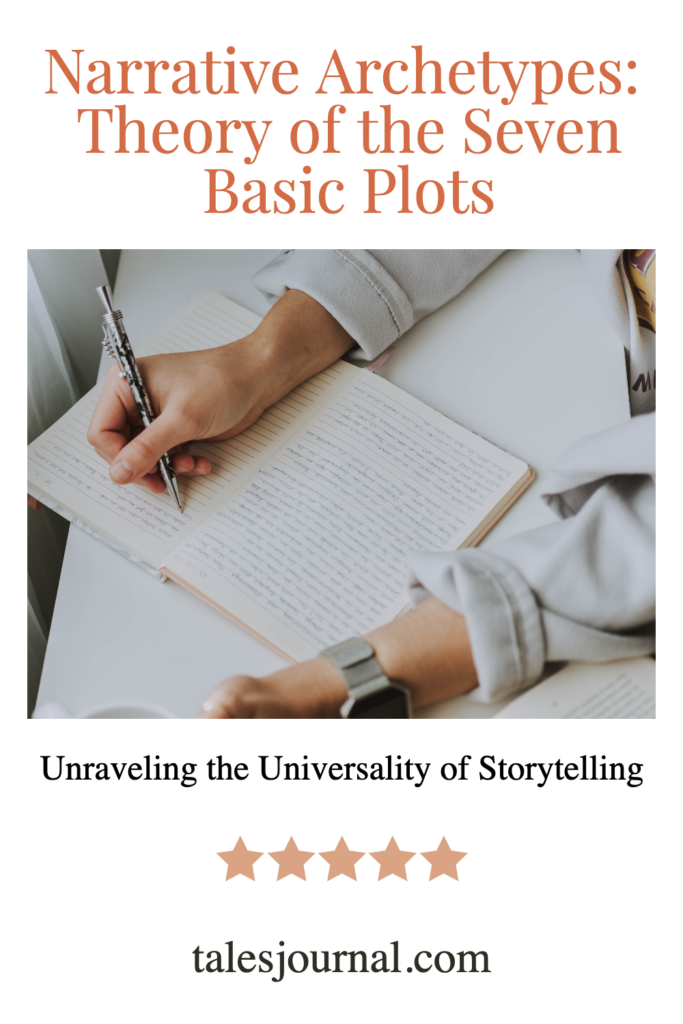Literature and storytelling are reflections of human life and the human condition. These narratives, whether expressed through prose, poetry, film, or oral traditions, serve not just as vehicles for entertainment, but also as crucial tools for understanding and interpreting human experiences and values. One particularly influential concept in narrative theory is Christopher Booker’s “The Seven Basic Plots,” a framework suggesting that all stories told throughout human history can be distilled into seven core narratives. This intriguing proposition offers a lens through which we can examine the fundamentals of storytelling across different cultures and time periods.
Table of Contents
 The “Seven Basic Plots” theory, proposed in Booker’s book of the same name, encapsulates a vast body of literary work and analysis, from ancient myths and epic poems to modern novels and cinema. Booker’s theory is not without its critics who argue that it oversimplifies narrative structures and limits the possibilities of storytelling. However, the theory’s enduring popularity speaks to its broad resonance and its effectiveness as a heuristic for understanding the complexities of narrative. It represents a unifying framework that highlights the universal themes and patterns within diverse storytelling traditions.
The “Seven Basic Plots” theory, proposed in Booker’s book of the same name, encapsulates a vast body of literary work and analysis, from ancient myths and epic poems to modern novels and cinema. Booker’s theory is not without its critics who argue that it oversimplifies narrative structures and limits the possibilities of storytelling. However, the theory’s enduring popularity speaks to its broad resonance and its effectiveness as a heuristic for understanding the complexities of narrative. It represents a unifying framework that highlights the universal themes and patterns within diverse storytelling traditions.
 Overcoming the Monster
Overcoming the Monster
Defining Characteristics:
The protagonist sets out to defeat an antagonistic force (often evil) that threatens the protagonist and/or the protagonist’s homeland.
Classic Examples:
The “Overcoming the Monster” plot is as old as storytelling itself, featuring a hero who must confront and overcome a formidable antagonist, or “monster.” The antagonist is often symbolic of our own fears and anxieties, and the protagonist’s victory signifies a triumph over these fears.
Rags to Riches
Defining Characteristics:
The poor protagonist acquires things such as power, wealth, and a mate, before losing it all and gaining it back, growing as a person as a result.
Classic Examples:
“Rags to Riches” tales are universal, and popular for their embodiment of the human desire to ascend socioeconomic barriers and achieve a better life. The protagonist’s journey from obscurity to prosperity, only after enduring trials and tribulations, inspires hope and assures readers that hard work and perseverance can lead to success.
The Quest
Defining Characteristics:
The protagonist and some companions set out to acquire an important object or to get to a location. They face temptations and other obstacles along the way.
Classic Examples:
The “Quest” narrative encapsulates the idea of a journey with a specific goal in mind. It symbolizes a deeper search for meaning, purpose, or truth. This plot is found in various cultural mythologies, reflecting universal human experiences of striving, sacrifice, and the drive toward accomplishment.
Voyage and Return
Defining Characteristics:
The protagonist goes to a strange land and, after overcoming the threats it poses or learning important lessons unique to that location, they return with experience.
Classic Examples:
The “Voyage and Return” storyline represents a transformative journey into an unknown world. It embodies the human process of self-discovery, learning, and evolution. The protagonist’s return signifies a reintegration into their original world, but with new wisdom or capabilities.
Comedy
Defining Characteristics:
A humorous series of events involving misunderstandings, with a peace-restoring ending.
Classic Examples:
“Comedy” in the context of Booker’s theory does not refer solely to humour but a structure where confusion and miscommunication lead to discord in a social group, which is finally resolved in a joyful or mirthful reconciliation. This plot resonates because it reflects the complexities and misunderstandings that occur in real-life social interactions, and our longing for harmonious resolutions.
Tragedy
Defining Characteristics:
The protagonist is a villain who falls from grace and whose death is a happy ending.
Classic Examples:
“Tragedy” in Booker’s context refers to a narrative where the protagonist, due to a fundamental flaw or mistake, experiences a significant downfall, often leading to their death or ruin. This plot serves as a cautionary tale about the consequences of personal weaknesses or moral failings.
Rebirth
Defining Characteristics:
An event forces the main character to change their ways, often making them a better person.
Classic Examples:
The “Rebirth” narrative represents a transformation or metamorphosis of the protagonist. It often involves the protagonist recognizing the error of their ways and undergoing a moral or psychological shift to become a better person. This plot reflects our inherent desire for redemption and personal growth.
 These seven basic plots provide a comprehensive framework for understanding storytelling across cultures and historical periods. However, it’s worth noting that not every story neatly fits into these categories, and many can be seen as hybrids or variations of these essential structures. Nevertheless, Booker’s theory provides a useful lens for examining and understanding the common patterns in our most enduring stories.
These seven basic plots provide a comprehensive framework for understanding storytelling across cultures and historical periods. However, it’s worth noting that not every story neatly fits into these categories, and many can be seen as hybrids or variations of these essential structures. Nevertheless, Booker’s theory provides a useful lens for examining and understanding the common patterns in our most enduring stories.
In examining Booker’s Seven Basic Plots, we observe the archetypal threads that connect diverse narratives from across centuries and cultures. From the hero’s journey to defeat an evil force in “Overcoming the Monster,” to the moral and personal transformation seen in “Rebirth,” each of these plots provides a unique insight into universal aspects of the human experience.
However, as compelling as Booker’s theory may be, it’s essential to recognize the multiplicity and diversity of narratives that exist outside or between these seven categories. Some stories may blend elements from multiple plots, or subvert these basic structures in innovative ways. Moreover, as cultural contexts evolve, new forms and themes of storytelling continue to emerge, reflecting changing societal values and experiences.
In conclusion, the Seven Basic Plots offer a broad, comprehensive framework for understanding the fundamental structures of storytelling, illuminating patterns that recur in narratives from all corners of the world. Despite its limitations and critiques, Booker’s theory serves as a valuable tool for literary analysis, helping us to recognize and appreciate the shared human themes at the heart of our most beloved stories. This exploration of the seven plots underscores the universality of storytelling as a vehicle for expressing our shared human experience, highlighting its potential to foster understanding and empathy across diverse cultures and societies.

References:
- Booker, Christopher (2004). “The Seven Basic Plots: Why We Tell Stories“. Continuum. ISBN 0-8264-5209-4.
- Vogler, Christopher (2007). “The Writer’s Journey: Mythic Structure For Writers“. Michael Wiese Productions. ISBN 978-1-932907-36-0.
- Campbell, Joseph (1949). “The Hero with a Thousand Faces“. New World Library. ISBN 1-57731-593-0.



 Overcoming the Monster
Overcoming the Monster









